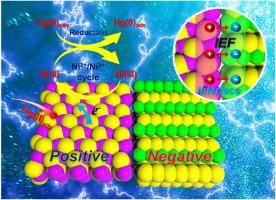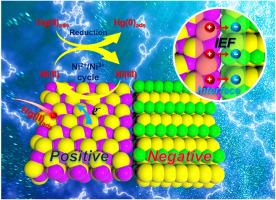基于加速 Ni2+/Ni3+ 循环的界面工程在 MoS2/NiS2 上灵敏检测 Hg(II):鉴定原子级异质结诱导的电子转移在电分析中的作用
IF 5.7
2区 化学
Q1 CHEMISTRY, ANALYTICAL
引用次数: 0
摘要
纳米材料中过渡金属离子的价态变化可以极大地提高对重金属离子(HMIs)的电化学检测性能,而如何进一步促进价态变化则是电分析领域的一个重大课题。本研究提出了一种将 MoS2 和 NiS2 结合在一起形成 MoS2/NiS2 复合物的界面工程学方法。密度泛函理论(DFT)结果表明,MoS2 和 NiS2 之间的新型原子级异质结将形成内电场(IEF),从而增强 MoS2/NiS2 复合物中 Ni 原子的电导率和价态变化行为,进而实现优异的检测性能。具体来说,由于 Ni2+/Ni3+ 循环相关的价态变化,MoS2/NiS2 复合物中原子级异质结的形成加速了电子转移。MoS2 上的活性 Mo4+ 物种充当电子供体,促进 NiS2 上的 Ni3+ 还原成 Ni2+,从而促进 Ni2+/Ni3+ 循环。正如预期的那样,MoS2/NiS2 复合物对 Hg(II)的检测性能优异,灵敏度达到 459.13 μA μM-1 cm-2,甚至超过了其他复合材料。总之,这些发现有望在构建异质结的基础上大大推进电子转移加速在电分析中的应用。本文章由计算机程序翻译,如有差异,请以英文原文为准。


Sensitive detection of Hg(II) on MoS2/NiS2 based on interfacial engineering to accelerate the Ni2+/Ni3+ cycle: Identification the role of atomic-level heterojunction-induced electron transfer in electroanalysis
The valence change of transition metal ions in nanomaterials can highly enhance the electrochemical detection performance toward heavy metal ions (HMIs), and how to further promote the valence change calls enormous concerns in electroanalysis. In this work, an interfacial engineering that combing the MoS2 and NiS2 together to form the MoS2/NiS2 complex is proposed. The density functional theory (DFT) results reveals that the novel atomic-level heterojunction between MoS2 and NiS2 will build an internal electric field (IEF), which leads to an enhanced conductivity and valence change behavior of Ni atoms in MoS2/NiS2 complex, resulting in a superior detection performance. In detail, the formation of atomic-level heterojunctions in the MoS2/NiS2 complex accelerates electron transfer due to the valence changes associated with Ni2+/Ni3+ cycling. The active Mo4+ species on MoS2 act as electron donors, facilitating the reduction of Ni3+ to Ni2+ on NiS2, thereby promoting Ni2+/Ni3+ cycling. As anticipated, the MoS2/NiS2 complex exhibits exceptional detection performance for Hg(II), with a sensitivity of 459.13 μA μM−1 cm−2, surpassing even that of other composite materials. In general, these findings are expected to significantly advance the application of electron transfer acceleration in electroanalysis based on the construction of heterojunction.
求助全文
通过发布文献求助,成功后即可免费获取论文全文。
去求助
来源期刊

Analytica Chimica Acta
化学-分析化学
CiteScore
10.40
自引率
6.50%
发文量
1081
审稿时长
38 days
期刊介绍:
Analytica Chimica Acta has an open access mirror journal Analytica Chimica Acta: X, sharing the same aims and scope, editorial team, submission system and rigorous peer review.
Analytica Chimica Acta provides a forum for the rapid publication of original research, and critical, comprehensive reviews dealing with all aspects of fundamental and applied modern analytical chemistry. The journal welcomes the submission of research papers which report studies concerning the development of new and significant analytical methodologies. In determining the suitability of submitted articles for publication, particular scrutiny will be placed on the degree of novelty and impact of the research and the extent to which it adds to the existing body of knowledge in analytical chemistry.
 求助内容:
求助内容: 应助结果提醒方式:
应助结果提醒方式:


